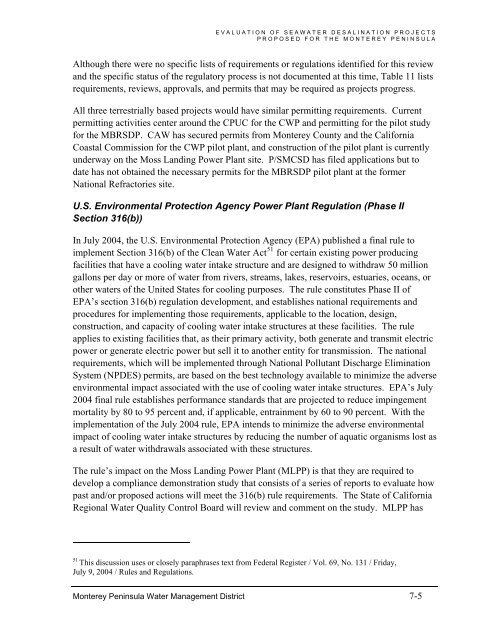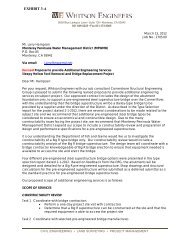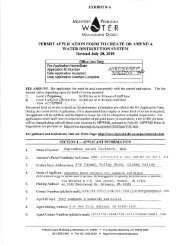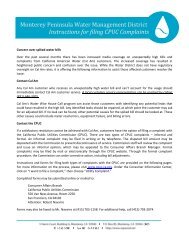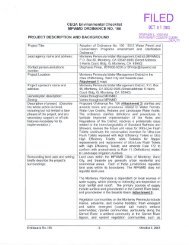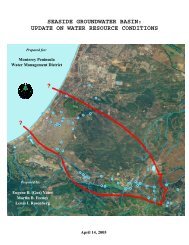FINAL REPORT Evaluation of Seawater Desalination Projects ...
FINAL REPORT Evaluation of Seawater Desalination Projects ...
FINAL REPORT Evaluation of Seawater Desalination Projects ...
You also want an ePaper? Increase the reach of your titles
YUMPU automatically turns print PDFs into web optimized ePapers that Google loves.
EVALUATION OF SEAWATER DESALINATION PROJECTS<br />
PROPOSED FOR THE MONTEREY PENINSULA<br />
Although there were no specific lists <strong>of</strong> requirements or regulations identified for this review<br />
and the specific status <strong>of</strong> the regulatory process is not documented at this time, Table 11 lists<br />
requirements, reviews, approvals, and permits that may be required as projects progress.<br />
All three terrestrially based projects would have similar permitting requirements. Current<br />
permitting activities center around the CPUC for the CWP and permitting for the pilot study<br />
for the MBRSDP. CAW has secured permits from Monterey County and the California<br />
Coastal Commission for the CWP pilot plant, and construction <strong>of</strong> the pilot plant is currently<br />
underway on the Moss Landing Power Plant site. P/SMCSD has filed applications but to<br />
date has not obtained the necessary permits for the MBRSDP pilot plant at the former<br />
National Refractories site.<br />
U.S. Environmental Protection Agency Power Plant Regulation (Phase II<br />
Section 316(b))<br />
In July 2004, the U.S. Environmental Protection Agency (EPA) published a final rule to<br />
implement Section 316(b) <strong>of</strong> the Clean Water Act 51 for certain existing power producing<br />
facilities that have a cooling water intake structure and are designed to withdraw 50 million<br />
gallons per day or more <strong>of</strong> water from rivers, streams, lakes, reservoirs, estuaries, oceans, or<br />
other waters <strong>of</strong> the United States for cooling purposes. The rule constitutes Phase II <strong>of</strong><br />
EPA’s section 316(b) regulation development, and establishes national requirements and<br />
procedures for implementing those requirements, applicable to the location, design,<br />
construction, and capacity <strong>of</strong> cooling water intake structures at these facilities. The rule<br />
applies to existing facilities that, as their primary activity, both generate and transmit electric<br />
power or generate electric power but sell it to another entity for transmission. The national<br />
requirements, which will be implemented through National Pollutant Discharge Elimination<br />
System (NPDES) permits, are based on the best technology available to minimize the adverse<br />
environmental impact associated with the use <strong>of</strong> cooling water intake structures. EPA’s July<br />
2004 final rule establishes performance standards that are projected to reduce impingement<br />
mortality by 80 to 95 percent and, if applicable, entrainment by 60 to 90 percent. With the<br />
implementation <strong>of</strong> the July 2004 rule, EPA intends to minimize the adverse environmental<br />
impact <strong>of</strong> cooling water intake structures by reducing the number <strong>of</strong> aquatic organisms lost as<br />
a result <strong>of</strong> water withdrawals associated with these structures.<br />
The rule’s impact on the Moss Landing Power Plant (MLPP) is that they are required to<br />
develop a compliance demonstration study that consists <strong>of</strong> a series <strong>of</strong> reports to evaluate how<br />
past and/or proposed actions will meet the 316(b) rule requirements. The State <strong>of</strong> California<br />
Regional Water Quality Control Board will review and comment on the study. MLPP has<br />
51<br />
This discussion uses or closely paraphrases text from Federal Register / Vol. 69, No. 131 / Friday,<br />
July 9, 2004 / Rules and Regulations.<br />
Monterey Peninsula Water Management District 7-5


